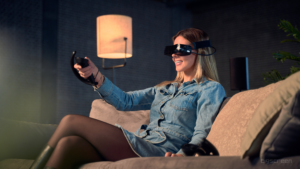No less an authority than John Carmack has given a thumbs up to a company that is trying to personalize the VR headset for maximum comfort. The $999 headset is available in Q3’23 but may be more of an experiment in enthusiasm than a revolutionary product.
VR headsets are not sexy. They are, for the most part, carbuncles of UX/UI. So, it isn’t any wonder that Bigscreen has managed to get noticed for its design by the man who is today’s yogi of VR, Carmack, co-founder of Oculus and former Meta employee who decried a lack of efficiency in the company before Mark Zuckerberg made it a mantra for his Wall Street allies.
So, do we have a product here? Not really. At least there is no inventory. Lots of nice videos and social media chatter and tech PR. But, we do have specifications, prototypes, delivery date, and a commitment to an idea that resonates and attracted aforementioned guru of VR. It is a personalized headset:
After ordering a Beyond, each customer will receive an email to scan themselves
Bigscreen
using Bigscreen’s iPhone application. Each Beyond is custom-made based on
the 3D face scan, which measures the shape of the customer’s face and the
position of their eyes. An iPhone XR or newer is required for the one-time 3D face
scan, and is not required to use the Beyond.
Bigscreen is using SteamVR for 6-DoF (degrees of freedom) tracking and access to the existing ecosystem of controllers, accessories and Steam content. The insides of the headset consists of a two OLED displays (2560×2560 pixel resolution) delivering 7.2-μm wide pixels, RGB stripe subpixels to reduce Screen Door Effect.
The Beyond does not support the Mac, focusing on Windows PCs, only to mitigate the demands of the deep integration that is required to manage display drivers, OSes, and GPUs. It has a 93 degree FOV and 58-72 mm IPD (inter-pupillary distance, or the space between the user’s pupils).
In general, the product falls short of being a complete offering (you may want to consider FOV numbers in the 120+ degrees range, perhaps), but it seems to have made some sacrifices in the build to make it as compact as it is. Apple will probably create a new must-have feature set once it establishes its own mixed reality headsets making every other headset developer have to conform to their specs to be competitive in the market. So, no Apple support, no market?
Developers can’t discount the fact that the Apple and PC interfaces will have to coexist, at some point, and that doesn’t augur well for compact designs in the short term. It’s going to be a tough market and may even create greater skeptics of those who are not sure about the opportunities for headsets. But, yes, there is no denying that headsets shouldn’t be one-size fits all, and that the very nature of human eyesight and individual face proportions are going to play a large part in determining the efficacy of a product.

